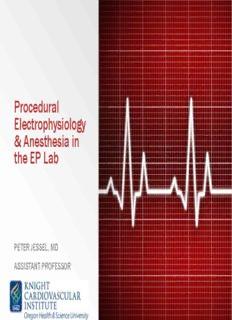
Procedural Electrophysiology & Anesthesia in the EP Lab PDF
Preview Procedural Electrophysiology & Anesthesia in the EP Lab
Procedural Electrophysiology & Anesthesia in the EP Lab PETER JESSEL, MD ASSISTANT PROFESSOR Outline ▪ The Clinical Electrophysiology Lab ▪ Common Arrhythmias and Management ▪ Atrial Fibrillation Ablation ▪ Complications ▪ Device Implantation ▪ Approach to Sedation and Anesthesia Introduction ▪ Initially EP labs were developed for diagnostic procedures ▪ EP studies were done for diagnosing bradyarrhythmias ▪ Focus is now primarily therapeutic for tachyarrhythmias and device implantation ▪ Electrophysiology procedures are becoming more complex and occurring in a sicker population ▪ Anesthesia is increasingly used as long procedures become more frequent ▪ The EP lab is an isolated environment with distinct challenges for the anesthesiology team The Clinical Electrophysiology Lab The Clinical Electrophysiology Lab ▪ Equipment: ▪ Programmed stimulator ▪ Recording system ▪ Biplane Fluoroscopy ▪ 3D mapping system ▪ RF generator ▪ Display boom ▪ Cryoablation system ▪ Intracardiac echo ▪ 2 biphasic defibrillators ▪ Magnetic navigation system (stereotaxis) EP Procedure Fundamentals ▪ Intracardiac electrograms ▪ EP catheters record the electrical activity of the heart ▪ Providing information on timing, position, voltage EP Procedure Fundamentals ▪ Most arrhythmias have a reentrant mechanism ▪ Typically a critical isthmus (slow conduction) that can be ablated to terminate the rhythm and render the local tissue electrically silent Standard EP Study Catheter Locations ▪ Standard 4 catheter diagnostic study ▪ High right atrium – approximates sinus node location ▪ His bundle – approximates AV nodal conduction ▪ Coronary Sinus – records LA/LV along mitral annulus ▪ RV apex Standard EP Study Catheter Locations RAO LAO SVT EP Study ▪ Usually pace in the ventricle first ▪ Then pace in the atrium ▪ If non-inducible – isoproterenol 1-10ug/min ▪ Prefer lightest sedation possible to increase chance of eliciting SVT ▪ Goal is to induce SVT and perform pacing maneuvers to define mechanism and location ▪ After a diagnosis made, a mapping/ablation catheter will be inserted
Description: